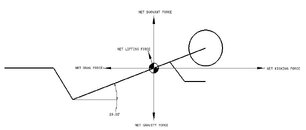Casey McKinley is one of the WKPP yukity-yuks. He's done more deep cave penetrations than anyone I will ever dive with. His normal trim is about 25* off from the horizontal. His head is slightly up, and his body from his chest to his knees is in a straight line 25* off from his direction of travel. His knees are bent, and his fins are pointed backwards. When he kicks, his fins are directed backwards, so his thrust is directed backwards. He still has perfect buoyancy, so between kicks, there is no change in depth, and he can hover motionless at will.
The point being the force from your fin kick is directed based on the orientation of your kick, not that of your body. The body is just resistance. If you develop a good bent knee frog kick, you can execute it in just about any orientation, even horizontally, like Uncle Pug apparently can!
Tom
Thing is I am not much into guru worship, what somebody is alleged to do or not do via a description over the internet via an observation third hand, sorry, that is not a valid argument, I will stay with what I said, read what I said
Off axis thrust will impart a rotational moment, scuba divers are not immune to the laws of nature. Maybe it is just that I am trained in engineering and science instead of urban legend-isms. I am also immune to and fully vaccinated against Kool-Aid, flying saucers and little green men.
N <---skeptical and critical analysis always trumps the accepted dogma
Last edited:






